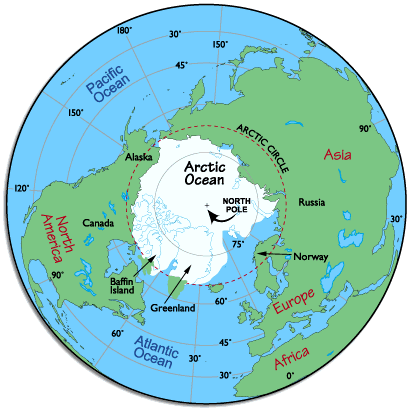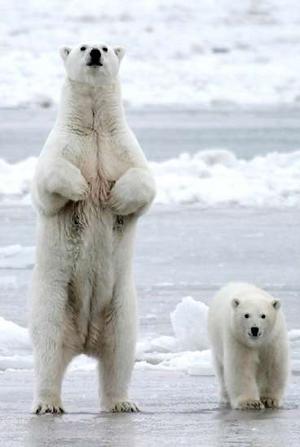Global Warming
Understanding the essential properties of water helps us understand the effect of global warming.
 |
Arctic Ice Sheet
- North Pole, floating
- summer area = 5,000,000 km^3
- winter area = 10,000,000 km^3
- thickness = 3-4 m
- average volume = 20,000 km^3
- main problem: positive feedback
- Wikipedia:
Polar Ice Packs
|
 |
 |
Antarctic Ice Sheet
- South Pole, on land
- area = 14,000,000 km^2
- average thickness = 2000 m
- maximum thickness = 4500 m
- volume = 30,000,000 km^3
- main problem: sea level rise
|
 |
Questions to Consider: Sea Level Rise
- Consider an ice cube melting in a glass of water.
- If the glass was exactly full before the ice melted, does it overflow when the ice melts?
- Does the number of water molecules contained by the glass change when the ice melts?
- What does this
experiment suggest?
- Look at the map of the Arctic Ocean.
- Is the Arctic ice cap floating or resting on land?
- Can it be treated analogously to the ice cube in the glass?
- If that ice melts, will sea level rise significantly?
- Will the melting of the Arctic Ice sheet affect sea level at all?
- Look at the map of Antarctica.
- Is the Antarctic ice cap floating or resting on land?
- If the Antarctic ice melts, will sea level rise significantly?
- If the Antarctic ice cap melts, the volume of water contained in that cap will spread out over
the world's ocean in a thin layer. Use dimensional analysis to write an equation that relates the
volume of water, the surface area of the ocean, and the depth of the layer.
- Sea Level Rise: the easy way. Use the volume of the Antarctic ice sheet and the surface area of the
world ocean (360,000,000 km^2), to estimate how much sea level will rise when the Antarctic ice sheet melts.
- Sea Level Rise: the easier way. Knowing that the oceans are 4,000 m deep and that 2% of the earth's water
is contained in glaciers on land (mostly Antarctica), esitmate the amount of sea level rise whent the glaciers
melt.
Current Research
We can make rough estimates of sea level rise, enough to know that mountianous regions won't be flooded.
Precise estimates require a lot of careful thought about thermal expansion of water, post-glacial rebound,
changing precipitation patterns and the like. A few things seem clear, however.
Within 100 years, if we don't make any changes to our lifestyles:
- the Arctic Ice sheet could disappear completely
- sea level could rise by up to one meter.
Does a 1 m sea level rise sound like a big deal? It's certainly not the apocalyptic vision of drowned
cities, skyskrapers as islands. But think of Venice - people using the canals to get to their front doors. Or
the Maldives, a nation in the Indian Ocean that could disappear completely. Closer to home, we'd definitely
see some flooding in coastal cities like Miami and New York. And your beach trip to the Outer Banks? Forget it.
Here is a map from the EPA, showing
coastal elevations in the Carolinas .
Questions to Consider: Energy of Melting and Warming
Albedo is a measure of how much light something reflects. Positive feedback means if something starts
happening (like ice melting), it changes conditions so that it happens faster and faster.
- Arctic Ice Sheet
- How thick is this ice?
- Which reflects more light, white ice or dark water?
- Which has the higher albedo?
- If the Arctic ice sheet melts by a few meters, will water be exposed?
- How does melting the Arctic ice sheet affect the albedo of the arctic area?
- When the Arctic ice sheet starts melting, will it melt at a steady rate, or faster and faster?
- Antarctic Ice Sheet
- How thick is this ice?
- Which reflects more light, ice or land?
- Which has the higher albedo?
- If the Antarctic ice sheet melts by a few meters, will land be exposed?
- When the Antarctic starts melting, will it melt steadily or faster and faster?
- Comparison: Will the Arctic or Antarctic Ice sheet experience positive feedback if it starts to melt?
- Time to melt each ice cap
- Divide the average thickness of the Antarctic ice sheet by the thickness of the Arctic ice sheet.
- Will the Antarctic ice sheet melt as quickly as the Arctic ice sheet?
- Why or why not?
- One m^3 of ice weighs 1000,000 g; one km^3 of ice weighs 10^(15)g.
Latent heat of melting ice = 80 cal/g, heat capacity of water = 1 cal/g/degree.
- What is the mass of the Arctic ice cap in grams?
- What is the mass of the Antarctic ice cap in grams?
- Multiply the area of the global ocean by 0.001 km to calculate the volume of the top layer of the ocean.
- What is the mass of the top layer of the ocean in grams?
- How much energy will it take to melt the Arctic ice cap?
- How much energy will it take to melt the Antarctic ice cap?
- How much energy will it take to raise the temperature of the ocean by 1 degree?
- The United States uses about 100 Quadrillion BTU's of energy each year, or 100 x 252 x 10^(15) calories.
Is that greater or less than the amount of energy you calculated above?



